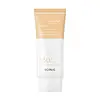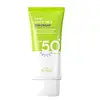What's inside
What's inside
 Key Ingredients
Key Ingredients

 Benefits
Benefits

 Concerns
Concerns

 Ingredients Side-by-side
Ingredients Side-by-side

Water
Skin ConditioningDibutyl Adipate
EmollientDipropylene Glycol
HumectantCI 77891
Cosmetic ColorantC12-15 Alkyl Benzoate
AntimicrobialCoco-Caprylate/Caprate
EmollientIsononyl Isononanoate
EmollientDiethylamino Hydroxybenzoyl Hexyl Benzoate
UV FilterPhenethyl Benzoate
EmollientGlycerin
HumectantBis-Ethylhexyloxyphenol Methoxyphenyl Triazine
Skin ConditioningEthylhexyl Triazone
UV AbsorberPolysilicone-15
UV FilterTerephthalylidene Dicamphor Sulfonic Acid
UV AbsorberPentylene Glycol
Skin Conditioning1,2-Hexanediol
Skin ConditioningPolyhydroxystearic Acid
EmulsifyingPoly C10-30 Alkyl Acrylate
Emulsion StabilisingPolyglyceryl-3 Methylglucose Distearate
EmulsifyingBehenyl Alcohol
EmollientTromethamine
BufferingPotassium Cetyl Phosphate
EmulsifyingIsododecane
EmollientOctyldodecanol
EmollientSodium Polyacryloyldimethyl Taurate
Emulsion StabilisingHydroxyethyl Urea
HumectantAluminum Hydroxide
EmollientHydroxyacetophenone
AntioxidantPanthenol
Skin ConditioningStearic Acid
CleansingHydroxyethyl Acrylate/Sodium Acryloyldimethyl Taurate Copolymer
Emulsion StabilisingPropanediol
SolventPolyglyceryl-4 Isostearate
EmulsifyingCI 77492
Cosmetic ColorantIsopropyl Titanium Triisostearate
EmollientPolyglyceryl-2 Dipolyhydroxystearate
Skin ConditioningHydroxypropyl Methylcellulose Stearoxy Ether
Polyacrylate Crosspolymer-6
Emulsion StabilisingAdenosine
Skin ConditioningPolyacrylic Acid
Emulsion StabilisingDisodium EDTA
Xanthan Gum
EmulsifyingCI 77491
Cosmetic ColorantBiosaccharide Gum-1
HumectantAcetyl Glucosamine
Skin ConditioningSodium Hyaluronate
HumectantSodium Hyaluronate Crosspolymer
HumectantCaprylyl Glycol
EmollientAllantoin
Skin ConditioningMadecassoside
AntioxidantBenzyl Glycol
SolventHydrolyzed Glycosaminoglycans
HumectantHydroxypropyltrimonium Hyaluronate
Hydrolyzed Hyaluronic Acid
HumectantEthylhexylglycerin
Skin ConditioningSodium Acetylated Hyaluronate
HumectantHyaluronic Acid
HumectantHydrolyzed Sodium Hyaluronate
Skin ConditioningPotassium Hyaluronate
Skin ConditioningWater, Dibutyl Adipate, Dipropylene Glycol, CI 77891, C12-15 Alkyl Benzoate, Coco-Caprylate/Caprate, Isononyl Isononanoate, Diethylamino Hydroxybenzoyl Hexyl Benzoate, Phenethyl Benzoate, Glycerin, Bis-Ethylhexyloxyphenol Methoxyphenyl Triazine, Ethylhexyl Triazone, Polysilicone-15, Terephthalylidene Dicamphor Sulfonic Acid, Pentylene Glycol, 1,2-Hexanediol, Polyhydroxystearic Acid, Poly C10-30 Alkyl Acrylate, Polyglyceryl-3 Methylglucose Distearate, Behenyl Alcohol, Tromethamine, Potassium Cetyl Phosphate, Isododecane, Octyldodecanol, Sodium Polyacryloyldimethyl Taurate, Hydroxyethyl Urea, Aluminum Hydroxide, Hydroxyacetophenone, Panthenol, Stearic Acid, Hydroxyethyl Acrylate/Sodium Acryloyldimethyl Taurate Copolymer, Propanediol, Polyglyceryl-4 Isostearate, CI 77492, Isopropyl Titanium Triisostearate, Polyglyceryl-2 Dipolyhydroxystearate, Hydroxypropyl Methylcellulose Stearoxy Ether, Polyacrylate Crosspolymer-6, Adenosine, Polyacrylic Acid, Disodium EDTA, Xanthan Gum, CI 77491, Biosaccharide Gum-1, Acetyl Glucosamine, Sodium Hyaluronate, Sodium Hyaluronate Crosspolymer, Caprylyl Glycol, Allantoin, Madecassoside, Benzyl Glycol, Hydrolyzed Glycosaminoglycans, Hydroxypropyltrimonium Hyaluronate, Hydrolyzed Hyaluronic Acid, Ethylhexylglycerin, Sodium Acetylated Hyaluronate, Hyaluronic Acid, Hydrolyzed Sodium Hyaluronate, Potassium Hyaluronate
Water
Skin ConditioningZinc Oxide
Cosmetic ColorantIsononyl Isononanoate
EmollientCaprylyl Methicone
Skin ConditioningPropylheptyl Caprylate
EmollientButylene Glycol
HumectantIsododecane
EmollientButyloctyl Salicylate
Skin ConditioningDisiloxane
Skin ConditioningCI 77891
Cosmetic ColorantAcrylates Copolymer
C12-15 Alkyl Benzoate
AntimicrobialPolymethyl Methacrylate
Polyhydroxystearic Acid
EmulsifyingAcrylates/Polytrimethylsiloxymethacrylate Copolymer
Skin ConditioningDisteardimonium Hectorite
StabilisingMagnesium Sulfate
Dimethicone
Emollient1,2-Hexanediol
Skin ConditioningPoly C10-30 Alkyl Acrylate
Emulsion StabilisingPolyglyceryl-3 Polydimethylsiloxyethyl Dimethicone
Skin ConditioningTriethoxycaprylylsilane
Aluminum Hydroxide
EmollientStearic Acid
CleansingPolyglyceryl-6 Polyhydroxystearate
EmulsifyingPolyglyceryl-6 Polyricinoleate
EmulsifyingPolyglyceryl-2 Dipolyhydroxystearate
Skin ConditioningCeresin
Emulsion StabilisingHydroxyacetophenone
AntioxidantPolyglycerin-6
HumectantTocopherol
AntioxidantAscorbyl Palmitate
AntioxidantAllantoin
Skin ConditioningCeramide NP
Skin ConditioningPanthenol
Skin ConditioningSodium Hyaluronate
HumectantDipropylene Glycol
HumectantMadecassic Acid
Skin ConditioningAsiatic Acid
Skin ConditioningAsiaticoside
AntioxidantVanilla Tahitensis Fruit Extract
Skin ConditioningTheobroma Cacao Seed Extract
AntioxidantWater, Zinc Oxide, Isononyl Isononanoate, Caprylyl Methicone, Propylheptyl Caprylate, Butylene Glycol, Isododecane, Butyloctyl Salicylate, Disiloxane, CI 77891, Acrylates Copolymer, C12-15 Alkyl Benzoate, Polymethyl Methacrylate, Polyhydroxystearic Acid, Acrylates/Polytrimethylsiloxymethacrylate Copolymer, Disteardimonium Hectorite, Magnesium Sulfate, Dimethicone, 1,2-Hexanediol, Poly C10-30 Alkyl Acrylate, Polyglyceryl-3 Polydimethylsiloxyethyl Dimethicone, Triethoxycaprylylsilane, Aluminum Hydroxide, Stearic Acid, Polyglyceryl-6 Polyhydroxystearate, Polyglyceryl-6 Polyricinoleate, Polyglyceryl-2 Dipolyhydroxystearate, Ceresin, Hydroxyacetophenone, Polyglycerin-6, Tocopherol, Ascorbyl Palmitate, Allantoin, Ceramide NP, Panthenol, Sodium Hyaluronate, Dipropylene Glycol, Madecassic Acid, Asiatic Acid, Asiaticoside, Vanilla Tahitensis Fruit Extract, Theobroma Cacao Seed Extract
Ingredients Explained
These ingredients are found in both products.
Ingredients higher up in an ingredient list are typically present in a larger amount.
1,2-Hexanediol is a synthetic liquid and another multi-functional powerhouse.
It is a:
- Humectant, drawing moisture into the skin
- Emollient, helping to soften skin
- Solvent, dispersing and stabilizing formulas
- Preservative booster, enhancing the antimicrobial activity of other preservatives
Allantoin is a soothing ingredient known for its protective and moisturizingg properties. Because of this, it is often added to products with strong active ingredients.
Studies show higher concentrations of this ingredient can promote wound healing.
Though it can be derived from the comfrey plant, allantoin is produced synthetically for cosmetic products to ensure purity.
Learn more about AllantoinAluminum Hydroxide is a form of aluminum. It can be naturally found in nature as the mineral gibbsite. In cosmetics, Aluminum Hydroxide is used as a colorant, pH adjuster, and absorbent.
As a colorant, Aluminum Hydroxide may add opacity, or reduce the transparency. Aluminum hydroxide is contains both basic and acidic properties.
According to manufacturers, this ingredient is an emollient and humectant. This means it helps hydrate the skin.
In medicine, this ingredient is used to help relieve heartburn and help heal ulcers.
There is currently no credible scientific evidence linking aluminum hydroxide in cosmetics to increased cancer risk.
Major health organizations allow the use of aluminum hydroxide in personal care products and have not flagged it as a carcinogenic risk at typical usage levels.
Learn more about Aluminum HydroxideC12-15 Alkyl Benzoate is made up of Benzoic Acid and long chain alcohols. It has a low molecular weight.
C12-15 Alkyl Benzoate is an emollient and texture enhancer. Due to its solubility, it is often used in sunscreens to help evenly distribute active ingredients.
As an emollient, C12-15 Alkyl Benzoate helps soften and hydrate your skin. Emollients create a film on your skin that traps moisture within.
This ingredient has been reported to cause eye irritation.
Learn more about C12-15 Alkyl BenzoateCi 77891 is a white pigment from Titanium dioxide. It is naturally found in minerals such as rutile and ilmenite.
It's main function is to add a white color to cosmetics. It can also be mixed with other colors to create different shades.
Ci 77891 is commonly found in sunscreens due to its ability to block UV rays.
Learn more about CI 77891Dipropylene Glycol is a synthetically created humectant, stabilizer, and solvent.
This ingredient helps:
Dipropylene glycol is technically an alcohol, but it belongs to the glycol family (often considered part of the ‘good’ alcohols). This means it is hydrating and gentle on skin unlike drying solvent alcohols like denatured alcohol.
As a masking agent, Dipropylene Glycol can be used to cover the smell of other ingredients. However, it does not have a scent.
Studies show Dipropylene Glycol is considered safe to use in skincare.
Learn more about Dipropylene GlycolHydroxyacetophenone is antioxidant with skin conditioning and soothing properties. It also boosts the efficiency of preservatives.
This ingredient is not irritating or sensitizing.
Isododecane is a fragrance, emollient, and solvent.
As an emollient, it helps your skin stay soft and hydrated. Emollients help trap moisture into your skin.
Isododecane's role as a solvent makes it a great texture enhancer. It spreads smoothly on skin and does not leave a sticky feeling behind. Isododecane also helps prevent color transfer in makeup products.
Isododecane is not absorbed into skin.
Learn more about IsododecaneIsononyl Isononanoate is a synthetic skin-conditioner and texture enhancer. It is created from nonanoic acid, a fatty acid found in cocoa and lavender oil.
As an emollient, Isononyl Isononanoate helps keep your skin soft and smooth. This is because emollients create a barrier on the skin to trap moisture in.
Isononyl Isononanoate helps give products a velvet feel and improves spreadability.
Learn more about Isononyl IsononanoatePanthenol is a common ingredient that helps hydrate and soothe the skin. It is found naturally in our skin and hair.
There are two forms of panthenol: D and L.
D-panthenol is also known as dexpanthenol. Most cosmetics use dexpanthenol or a mixture of D and L-panthenol.
Panthenol is famous due to its ability to go deeper into the skin's layers. Using this ingredient has numerous pros (and no cons):
Like hyaluronic acid, panthenol is a humectant. Humectants are able to bind and hold large amounts of water to keep skin hydrated.
This ingredient works well for wound healing. It works by increasing tissue in the wound and helps close open wounds.
Once oxidized, panthenol converts to pantothenic acid. Panthothenic acid is found in all living cells.
This ingredient is also referred to as pro-vitamin B5.
Learn more about PanthenolThis ingredient is a polymer made from acrylic acid esters and long-chain (C10–C30) alcohols.
It is used as an emulsion stabilizer and viscosity controlling agent. This helps products maintain a smooth and uniform texture.
Polyglyceryl-2 Dipolyhydroxystearate isn't fungal acne safe.
Polyhydroxystearic Acid is a soft wax made from castor oil.
It is is a texture thickener, emulsifier, and film-former. Emulsifiers prevent ingredients from separating, such as oils and waters.
Polyhydroxystearic Acid may not be fungal acne safe.
Learn more about Polyhydroxystearic AcidSodium Hyaluronate is hyaluronic acid's salt form. It is commonly derived from the sodium salt of hyaluronic acid.
Like hyaluronic acid, it is great at holding water and acts as a humectant. This makes it a great skin hydrating ingredient.
Sodium Hyaluronate is naturally occurring in our bodies and is mostly found in eye fluid and joints.
These are some other common types of Hyaluronic Acid:
Learn more about Sodium HyaluronateStearic Acid is a fatty acid. It is an emollient, emulsifier, and texture enhancer.
As an emollient, stearic acid helps soften skin. It aids the skin's protective barrier by preventing water loss. It also provides a gentle cleansing effect without stripping away natural oils.
Stearic acid may also be used to enhance the texture of products. It can add volume and stabilize ingredients such as water and oil. This can help water and oil ingredients from separating.
Sources of stearic acid include animal or vegetable fats/oils such as coconut or shea. It can be naturally found in butter, cocoa butter, shea butter, vegetable fats, and animal tallow.
This ingredient may not be Malassezia folliculitis, or fungal-acne safe.
Learn more about Stearic AcidWater. It's the most common cosmetic ingredient of all. You'll usually see it at the top of ingredient lists, meaning that it makes up the largest part of the product.
So why is it so popular? Water most often acts as a solvent - this means that it helps dissolve other ingredients into the formulation.
You'll also recognize water as that liquid we all need to stay alive. If you see this, drink a glass of water. Stay hydrated!
Learn more about Water